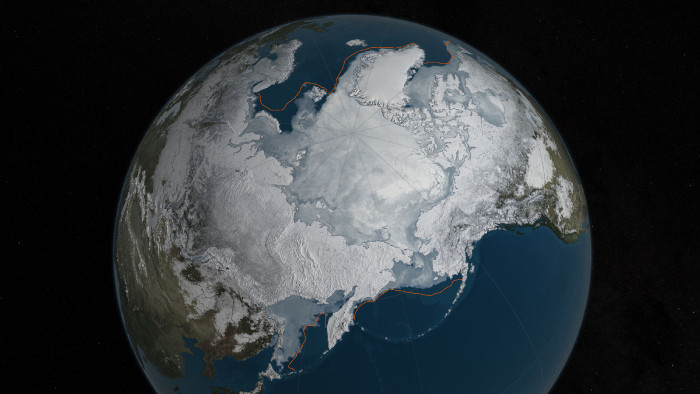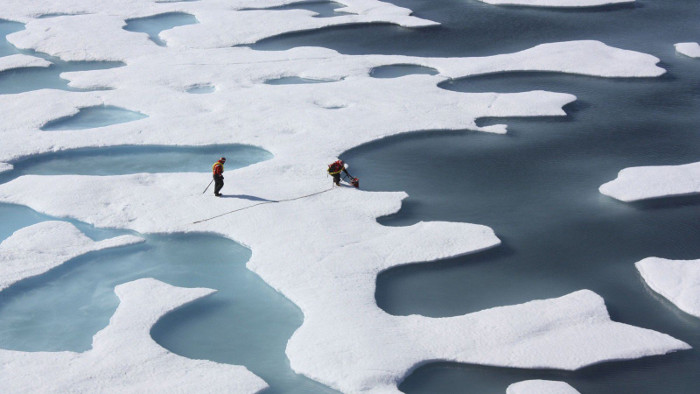Arctic ice is melting record fast
Arctic ice has dropped to a record low continuously in the past two years, threatening global climate is getting warmer.
According to data recently released by scientists at the US National Snow and Ice Data Center (NSIDC) and NASA, the Arctic ice has reached a record low this winter. This is also a record low for 2 consecutive years.

Ice in the Arctic has hit a record low this winter.
Record of record
According to ScienceDaily, every year, the sea ice in the Arctic Ocean and the surrounding seas often have a melting spell during the spring and summer, then re-form in the autumn and winter months. The level of melting often peaks between February and April.
On March 24, the Arctic ice area recorded 14.52 million square kilometers, the record low level recorded in winter through satellites since 1979. This level is also 0.2% lower. compared to the record set earlier in the year was 14.54km 2 . This is even the 13th lowest level of ice recorded by satellites over the past 13 years.
In the period from 1981 to 2010, Arctic ice area decreased by 7% compared to the average period of that period of 15.64km 2 .
Climate change, narrow sea ice
Notably, this phenomenon only occurred shortly after scientists announced, the period from December 2015 to February 2016 is possessing a record high temperature.The warming of the atmosphere may be the leading cause of the decline in ice area in the Arctic.

On March 24, the Arctic ice area recorded 14.52 million km2.
According to scientist Walt Meier, of NASA's Goddard Space Center in Greenbelt, Maryland, air temperatures of up to -12 degrees Celsius, above average every year, have caused the sea ice to get thinner and thinner.
Wind activity in the Arctic during January and February is also not strong enough to form ice blocks. For reasons, they brought warm air from the south and prevented the expansion of the ice. However, what Meier emphasized is the main cause of the current situation, which is the warming of the sea.
"There is a possibility that we will continue to see the winter sea ice area becoming lower and lower in the future, because the temperature of the atmosphere is warming, and the oceans also warm up. Ocean prevented sea ice from expanding south, " Meier said.
"Although the maximum amount of ice can be altered depending on winter weather conditions. However, we are seeing a significant trend in reducing ice mass. It is related to the phenomenon of increasing heat in the atmosphere. and ocean, " Meier added.

Warming of the ocean prevents sea ice from expanding south.
It has been known since 1979 that the trend of rising heat in the atmosphere and the ocean has "wiped out" more than 1.6 million square kilometers of sea ice in the winter. This area can be twice as large as Texas and America.
Can it stop?
The record low ice in winter does not mean that the ice will continue to be lower in the summer. Summer weather conditions have the greatest impact on the scale of sea ice, and that is often the end result after the melting cycle each year. If the temperature is warm and there is a summer storm, the ice melt will be faster and vice versa.
Arctic sea ice plays an important role in regulating the temperature of the Earth's surface. White ice surfaces will reflect light and solar energy more efficiently. If that amount of ice is lost, the sea will be the machine that must "shoulder" the task of regulating global temperature and climate. However, the effectiveness of sea ice is only promoted most strongly at summer time when the Sun shines more.
Meanwhile in the winter, the impact of block ice decline in the Arctic is most evident in the warm atmosphere.
According to climate scientist Jennifer Francis of the University. Rutgers in New Brunswick, New Jersey said: "Where the surface of the sea ice is lost, that water will be the place to transfer heat to the atmosphere, because the atmosphere is colder than the freezing sea. When winter sea ice disappears, areas with unusually warm atmospheric temperatures in the Arctic will expand, which are areas of increased evaporation, cloud formation, and surface formation. Earth warms up ".

Arctic sea ice plays an important role in regulating the temperature of the Earth's surface.
For scientist Ted Scambos, head of NSIDC in Colorado, the decline in sea ice is a serious "crisis" . This phenomenon is increasing year by year, and it is difficult to predict the impact on the global climate. Not to mention, measures to prevent human problems are still just lying on paper.
Tracking mass tape changes led to record low volumes this year.
- The Arctic ice color is closely linked to climate change
- Every second 14,000 tons of water flows into the sea because the Arctic ice melts
- Discover the ancient village of Eskimo under the ice melting in the Arctic
- The volume of ice in the Arctic drops to a record low
- Antarctic glaciers are melting faster
- Walrus migrated massively from the North Pole to the United States
- Beautiful scenery is unique in the North Pole
- The Arctic ice melted four times faster than forecast
- Warming in the Arctic will affect Vietnam
- For the first time in 100,000 years, the Arctic ice can melt completely
- America takes advantage of Arctic ice to track submarines
- Arctic melting ice could cause $ 60,000 billion in damage
 Is the magnetic North Pole shift dangerous to humanity?
Is the magnetic North Pole shift dangerous to humanity? Washington legalizes the recycling of human bodies into fertilizer
Washington legalizes the recycling of human bodies into fertilizer Lightning stone - the mysterious guest
Lightning stone - the mysterious guest Stunned by the mysterious sunset, strange appearance
Stunned by the mysterious sunset, strange appearance Plan to build giant canopy over Antarctica has problems
Plan to build giant canopy over Antarctica has problems  Why does ice stick to your hands when you hold it?
Why does ice stick to your hands when you hold it?  NASA releases ice map on Mars
NASA releases ice map on Mars  After 389 days in the Arctic, costing more than $160 million, hundreds of scientists brought back bad news: What was it?
After 389 days in the Arctic, costing more than $160 million, hundreds of scientists brought back bad news: What was it?  650,000-year-old 'gateway to the underworld' discovered in Siberia
650,000-year-old 'gateway to the underworld' discovered in Siberia  How to explain the strange ice circle that rotates like a time-travel door?
How to explain the strange ice circle that rotates like a time-travel door? 